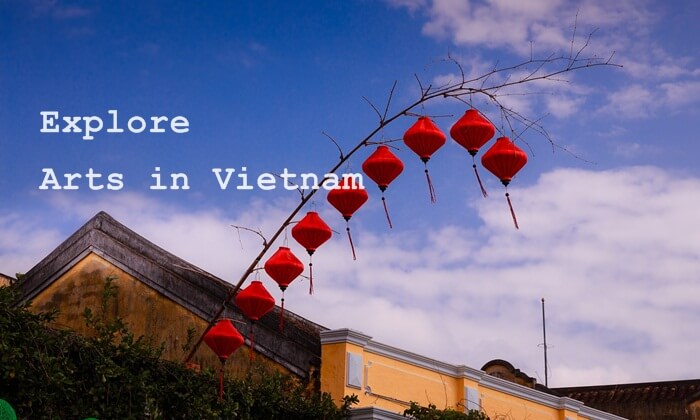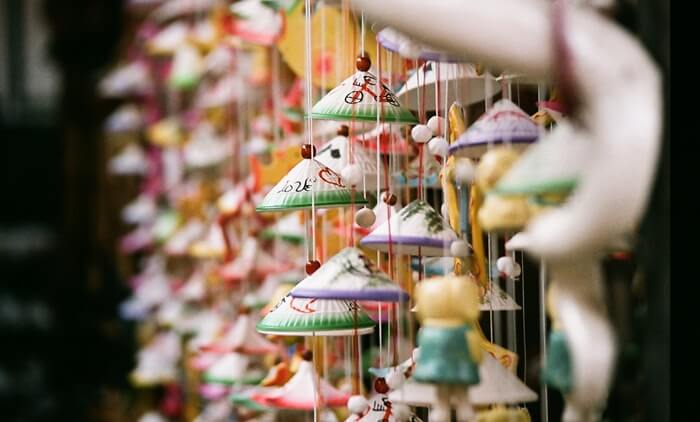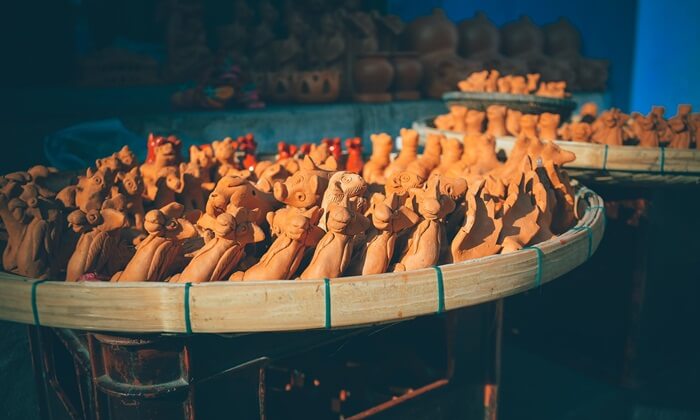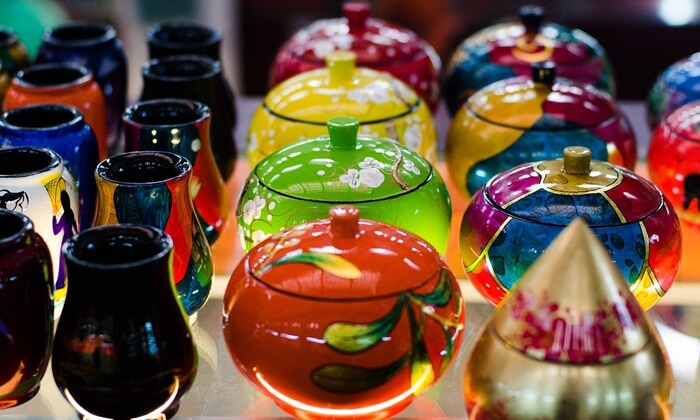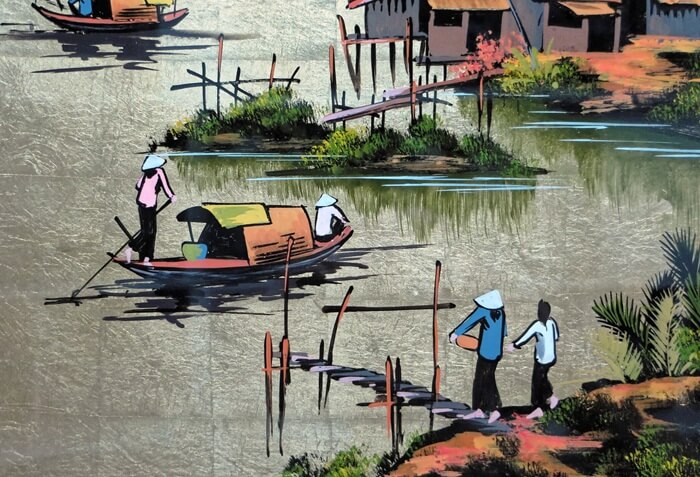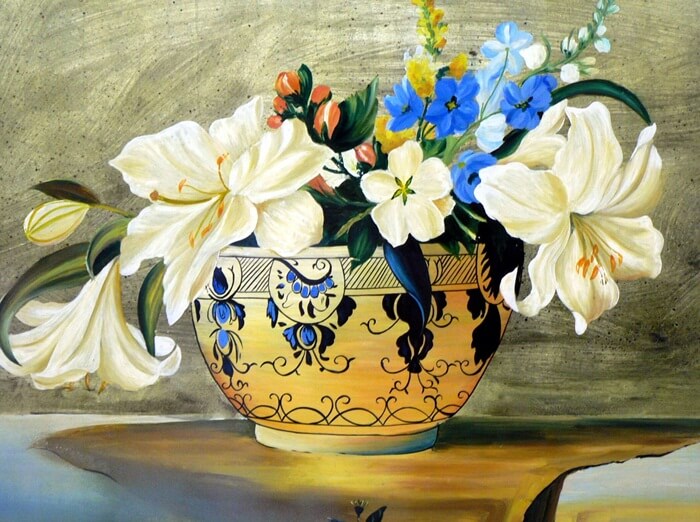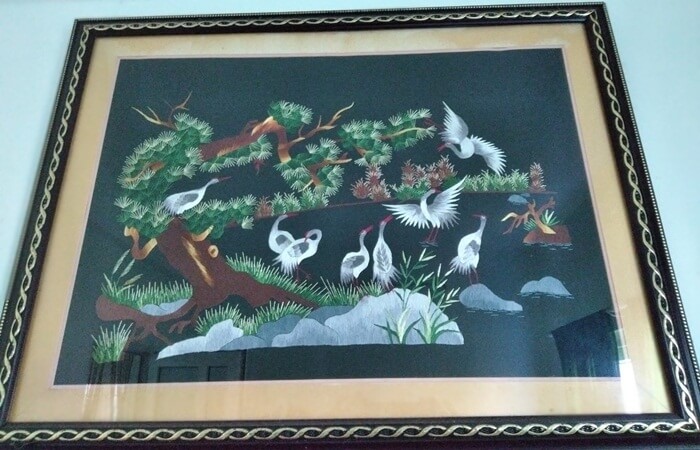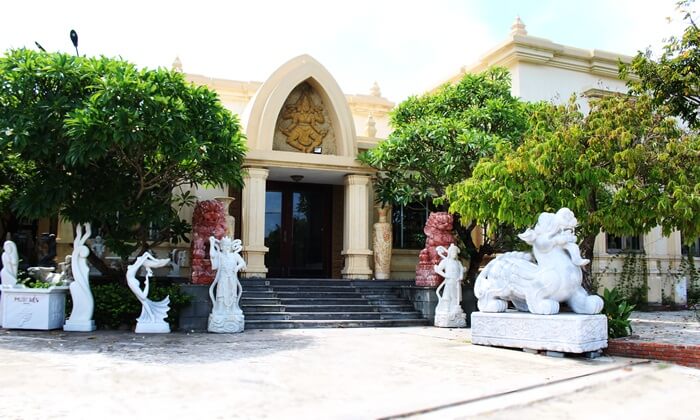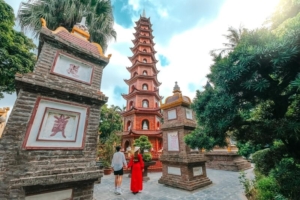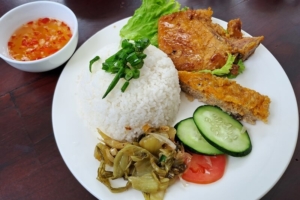The arts in Vietnam formed and developed parallel to the country’s continuous development history. The first works of art found here date back to the Stone Age.
After nearly ten thousand years, what remains in the Vietnamese art scene has become extremely rich, sophisticated, unique, and attractive. It deserves to become a great experience for everyone.
What kind of art can be discovered in Vietnam? What art products in Vietnam can be brought back as a perfect gift for a loved one? Is it too expensive to own a beautiful work of Vietnamese art?
Vietnamdrive will introduce the art form of Vietnam that you should explore.
1. Ceramics
Ceramics are the oldest form of art in Vietnam. According to archaeological studies, the first ceramic products appeared in Vietnam about ten thousand years ago. Throughout history, this art has been continuously modified and perfected to create perfect works of art.
Although the Chinese pottery style greatly influenced Vietnamese ceramics during Northern domination (before the 10th century), the products made by Vietnamese artisans still have their unique imprints. They are a combination of indigenous culture and technology imported from China, India, Cambodia, and Champa.
Historically, the most brilliant development period of Vietnamese ceramic art was the Ly – Tran dynasties (1009-1400). At this stage, production scale, techniques, materials, and kilns all underwent major creative changes.
Until now, the art of Vietnamese ceramics has been developed in the country and widely exported around the world. The products are becoming increasingly sophisticated and unique, showing the imprint of traditional culture and modern style.
Outstanding addresses to discover Vietnamese ceramic art:
- Bat Trang Ceramics: Bat Trang commune, Gia Lam district, Hanoi.
- Chu Dau Pottery Village: Nam Sach district, Hai Duong province.
- Lai Thieu Pottery Village – Tan Phuoc Khanh (Binh Duong): Tan Phuoc Khanh town, Tan Uyen district, Binh Duong province.
- Thanh Ha Pottery Village: Hoi An City, Quang Nam province.
- Bau Truc Ceramics: Phuoc Dan town, Ninh Phuoc district, Ninh Thuan province.
The price of Vietnamese ceramic products fluctuates greatly depending on the sophistication and specific design. At the same time, a tea set includes a whole kettle; the price ranges from a few hundred thousand to nearly a million dong. A pair of vases can cost up to several tens of millions of dollars.
However, you can also buy a To He (animal whistle) from Thanh Ha Pottery Village, sold all over the streets in Hoi An Old Town for 15,000 VND. Therefore, depending on your preferences and needs, you can buy Vietnamese ceramic products at any price range.
2. Lacquerware
Lacquer wares are household products, such as vases, jars, trays, boxes, caskets, bowls, plates, etc., made using the lacquer technique.
This technique is developed and advanced from the traditional art of painting. It combines many crafts, such as painting, eggshells, and oysters, sticking gold leaves and silver, polishing, decorating, drawing patterns, color coating, and water grinding.
Artisans usually take up to 3 months to perform, with about 20 different stages, to produce a perfect lacquer product. All stages require meticulous, careful, and highly skilled technicians.
If traditional lacquer art was limited by dominant colors, such as cockroach color, black, and red, nowadays, the colors on lacquer products are no longer restricted. The flexibility, freedom of color, and richness of form have brought lacquer to new heights of art in Vietnam.
Today’s lacquer products are extremely delicate and eye-catching, with iridescent, glossy, smooth colors. They are perfect as art decorations for any living or working space.
In Vietnam, prominent lacquer villages are:
- Ha Thai lacquer village: Duyen Thai commune, Thuong Tin district, Hanoi.
- Boi Khe lacquer craft village: Chuyen My commune, Phu Xuyen district, Hanoi.
- Tuong Binh Hiep lacquer village: Tuong Binh Hiep ward, Thu Dau Mot City, Binh Duong province.
Lacquer products are sold quite popularly, and you can find them at shopping malls in Vietnam, tourist markets, or souvenir stalls. The average price ranges from fifty thousand to several million Vietnamese dongs for a standard product, such as cups, plates, vases, paper boxes, jewelry boxes, trays, etc.
3. Lacquer Painting
It would be an omission to discuss the arts in Vietnam and ignore the lacquer painting, which originated from the locals’ creation.
The original cradle of lacquer painting belonged to the Indochina College of Fine Arts, with famous Vietnamese painters such as Tran Van Can, Dinh Van Thanh, Nguyen Khang, Pham Hau, Nguyen Gia Tri, etc.
In 1925, the French painter Joseph Inguimberty, a lecturer in the decoration department of the Indochina Fine Arts College, discovered a unique feature in the art of painting laque (a local lacquer technique). He proposed to put ta (laque) in research and development in the art of painting. Through many experimental studies, the local skill has been elevated to a new position to create the unique art of Lacquer Painting.
After less than ten years, the completed lacquer paintings were born, creating a new wave of excitement. In 1937, for the first time, Vietnamese lacquer paintings entered France at an international art fair in Paris.
The value of a lacquer painting lies in the depth of the painting and the subtle gloss of the work. In particular, the splendid beauty of a lacquer painting lasts quite a long time. Perhaps this results from the artist’s elaborate, meticulous, and enthusiastic creation process.
Today, coming to Vietnam, finding a place selling lacquer paintings is relatively easy. In most big cities, lacquer paintings are sold quite popularly in galleries, souvenir stalls, and tourist attractions. The price of a lacquer painting fluctuates wildly, from less than one million Vietnamese dongs to tens of millions of dongs and more for a proportional value.
Typical places selling lacquer paintings:
- Green Palm Gallery: No. 39 Hang Gai, Hanoi; or 49 Mac Thi Buoi, Ben Nghe Ward, District 1, Ho Chi Minh City.
- Nguyen Art Gallery: No. 31A, Temple of Literature, Hanoi.
- Apricot Gallery: No. 40B Hang Bong, Hoan Kiem District, Hanoi; or 50-52 Mac Thi Buoi, District 1, Ho Chi Minh City.
4. Silk Painting
If lacquer painting is the result of elaborate creativity based on hard and rough materials such as wood, paint, eggshell, etc., silk painting is the result of creativity created on soft silk fabric and pride.
Silk paintings appeared quite early in Asian countries where silk weaving was strongly developed, such as China, Japan, and Vietnam.
Instead of painting on paper, the artist will create fine artwork on a smooth, soft, fantastic, and absorbent silk fabric.
The beauty of the silk background combines with the delicate strokes of the artist, creating pure and flexible masterpieces.
The more silk artists understand silk and know how to fully exploit the strengths of this unique painting material, the more luxurious and beautiful the work will be.
In Vietnam, silk paintings are sold quite popularly in most galleries. The price of silk paintings also depends on their aesthetic and artistic value. Typically, silk paintings by famous Vietnamese artists cost up to millions of dollars.
However, with silk paintings of aesthetic value used to decorate living and working spaces, their prices range from 400,000 VND to 1,500,000 VND. With this price, silk paintings become not too picky about buyers.
>> Please see more about the traditional silk painting in Vietnam.
5. Hand embroidery
Regarding Vietnamese traditional art, it is impossible to ignore the art of hand embroidery. It is an art form closely associated with Vietnamese cultural life, as a long-standing saying: “Boys read books and recite poems; Girls work needles, embroider and sew.”
Historically, most Vietnamese women had to know how to embroider by hand; it was a mandatory rule for every girl. Today, hand embroidery is taught as a formal subject in the general education curriculum.
Hand embroidery is a form in which embroiderers use needles to decorate threads of different colors on the fabric to create beautiful patterns, such as flowers, birds, landscapes, etc. Hand embroidery can be done on clothes, scarves, tablecloths, pillows, decorative items, or create valuable embroidery pictures.
In Vietnam, the most brilliant development period of hand embroidery was during the reign of King Bao Dai (1921 – 1945). Queen Mother Tu Cung (Hoang Thi Cuc) and Nam Phuong Queen contributed significantly to developing the Vietnamese hand embroidery profession.
Embroidery products at that time combined the quintessence of traditional style with the modern embroidery techniques of the West. At the same time, they integrated the meek, delicate, and loving nature of Hue women.
Today, the traditional art of hand embroidery with Hue royal colors is still maintained.
The famous addresses to discover this art of hand embroidery, such as:
– XQ Vietnam:
- XQ Da Lat Su Quan: No. 80 Mai Anh Dao, Ward 8, City. Da Lat, Lam Dong Province.
- XQ Hue Embroidery Art Museum: 01 Pham Hong Thai, Hue City.
In addition to the above addresses maintaining traditional embroidery with Hue imperial style, it is not difficult to find products of conventional hand embroidery in other places in Vietnam, such as at Thang Loi Handicraft: 92 Phan Boi Chau Street, Hoi An City, Quang Nam Province.
From unique embroidered paintings to decorative products, hand-embroidered scarves are sold extensively in the local markets in Vietnam, tourist attractions, galleries, etc.
Hand-embroidered art products in Vietnam are also not too expensive. Depending on the art’s quality and the product’s size, the price can range from a few hundred thousand dongs to several million dongs or more.
6. Hoi An Lanterns
Hoi An, a prominent name that cannot be ignored, is on the tourist map of Vietnam. This beautiful little city attracts tourists with many lovely attractions. Among the many attractions is the presence of lanterns everywhere in the old town.
Thousands of lanterns of all colors and shapes are hung up to symbolize the love that Hoi An people have for the place they live. They represent the wish that happiness, luck, and health will come to everyone in the family and neighborhood. These lanterns also light up the shimmering and fanciful painting of Hoi An every night.
The attraction of Hoi An lanterns also lies in their artistic value. They are a handmade product directly made by the locals on silk fabric in all colors and eye-catching patterns. The fabric is stretched on a carefully treated bamboo or wooden frame to create beautiful shapes.
The lantern can be easily stowed and carried as a neat piece of luggage. Because of its durability, Hoi An lanterns are suitable for decoration both indoors and outdoors.
The price of Hoi An lanterns is low. Small lanterns cost only tens of thousands of Vietnamese dong, while larger ones cost a few hundred or a little more.
In particular, coming to Hoi An, you can participate in the direct experience of making lanterns with the locals. A lesson in making lanterns here ranges from 200,000 VND to 300,000 VND per person. And traveling to this beautiful little city deserves to be a fun activity.
Addresses to learn how to make lanterns in Hoi An:
- Den Long Viet (Viet Lantern): 57 Ba Trieu, Hoi An City, Quang Nam province
- Tieng Vong Pho (Echoing Town Lantern): 08 Tran Cao Van, Hoi An City, Quang Nam Province
- Ha Linh Lantern: 72 Tran Nhan Tong, Cam Chau Ward, Hoi An City, Quang Nam Province
7. The art of stone carving
There is no historical evidence showing Vietnamese fine art sculptures’ exact date of birth. But it can be confirmed that fine art stone carving is one of the traditional crafts that appeared very early in this lovely Southeast Asian country – Vietnam.
It is asserted that Thanh Hoa province, located in northern central Vietnam, is the cradle of Vietnamese stone sculpture. From here, the art of stone sculpture spread to many places across the country.
Coming to the stone village, you will see a craftsman bringing the essence of art blowing into inanimate rocks to create fine artworks with the soul of culture and daily life.
From the stone selection stage to the final steps to produce a product with an eye-catching shape, all require a lot of experience and meticulousness from the craftsman. They must work hard in their intense love for the stone.
Products made in the early days mainly revolved around essential needs, such as stone mortars, flower pots, teapots, etc. As society developed, stoneware products became increasingly diverse in models, shapes, and sizes.
Today, when visiting stone carving villages, you can find many different options suitable for your needs. You can choose from small models to display in the living room to large artworks to decorate gardens, gates, restaurants, hotels, etc.
The price of fine art stone products also depends on their size, design, and material, which can be quite different. However, most reviews say that the cost of owning a sophisticated stone art product from Vietnam is completely in line with buyers’ expectations.
Currently, there are still many famous stone-carving villages, such as:
- Nhoi stone village: located in An Hoach Ward and Dong Hung, Dong Tan communes, Thanh Hoa City, Thanh Hoa province.
- Non Nuoc stone village in the marble mountains: Hoa Hai ward, Ngu Hanh Son district, Da Nang City.
- Ninh Van stone village: Ninh Van commune, Hoa Lu district, Ninh Binh province.
The 7 unique types of arts that Vietnamdrive has just introduced are outstanding traditional arts of Vietnam.
When coming to this beautiful and hospitable country, do not miss the opportunity to discover the beauty of these art forms.
It will be an exciting experience when you can hear, see, and touch the product, and directly make an example and take it away as a valuable souvenir.
In addition to the art forms mentioned above, many other arts in Vietnam are waiting for you to discover, such as Dong Ho Painting.
